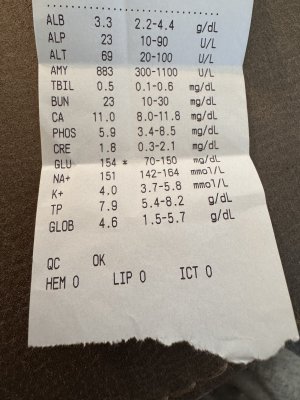Chris and Biscuits
New member
Hi, I'm Chris and our cat is Biscuits (info in signature). A week ago Monday Biscuits started showing signs of being sick, lethargic and wouldn't eat. We took her to the vet Tuesday and after running tests she was taken to the emergency hospital in extreme DKA with a UTI. The first 3 days she showed little to no improvement. Ultrasound didn't show anything. They couldn't get enough potassium in through IV so they put in a nasal feeding tube. On day 4 she made a turnaround, started getting up and moving but her back legs would give out. She started eating a little. They took her off IV day 5 and we brought her home the morning of day 6.
At 8pm day 6 we were told to give her 1u of Lantus if she ate. She would not eat anything so we freaked out. I tested her BG and it was 129, which freaked me out even more because from what I've read that is too low for insulin anyway.
Day 7 she ate 1/4 wet food and would not eat any more. I tested her BG and it was 121, so i freaked out again and did not give her insulin. I tested 3 hours later and it was 135. We took her to the vet 3 hours later and ran a full blood panel - everything looked good...BG was 149. The only thing that looked slightly off was Potassium at 4. The primary vet gave us Lactulose to encourage eating and put on a libre 3 so they could also track her BG.
Day 8. She ate 1/2 last night and maybe 1/2 this morning. Her BG levels have been between 120 and 150 for 24 hours. She did go #1 and #2, but otherwise does not get up or move and her back legs severely struggle to make it 5-10 ft.
Day 9 (today) same as day 8.
So my questions are:
Is it normal for a cat with no previous signs of diabetes go into full on DKA and come out the other side with only slightly elevated BG levels?
What does the recovery typically look like after an event like this? Is it days/weeks/months to recover? How concerned should we be that she isn't fully eating? How concerned should i be about the back legs?
At 8pm day 6 we were told to give her 1u of Lantus if she ate. She would not eat anything so we freaked out. I tested her BG and it was 129, which freaked me out even more because from what I've read that is too low for insulin anyway.
Day 7 she ate 1/4 wet food and would not eat any more. I tested her BG and it was 121, so i freaked out again and did not give her insulin. I tested 3 hours later and it was 135. We took her to the vet 3 hours later and ran a full blood panel - everything looked good...BG was 149. The only thing that looked slightly off was Potassium at 4. The primary vet gave us Lactulose to encourage eating and put on a libre 3 so they could also track her BG.
Day 8. She ate 1/2 last night and maybe 1/2 this morning. Her BG levels have been between 120 and 150 for 24 hours. She did go #1 and #2, but otherwise does not get up or move and her back legs severely struggle to make it 5-10 ft.
Day 9 (today) same as day 8.
So my questions are:
Is it normal for a cat with no previous signs of diabetes go into full on DKA and come out the other side with only slightly elevated BG levels?
What does the recovery typically look like after an event like this? Is it days/weeks/months to recover? How concerned should we be that she isn't fully eating? How concerned should i be about the back legs?
Last edited:

